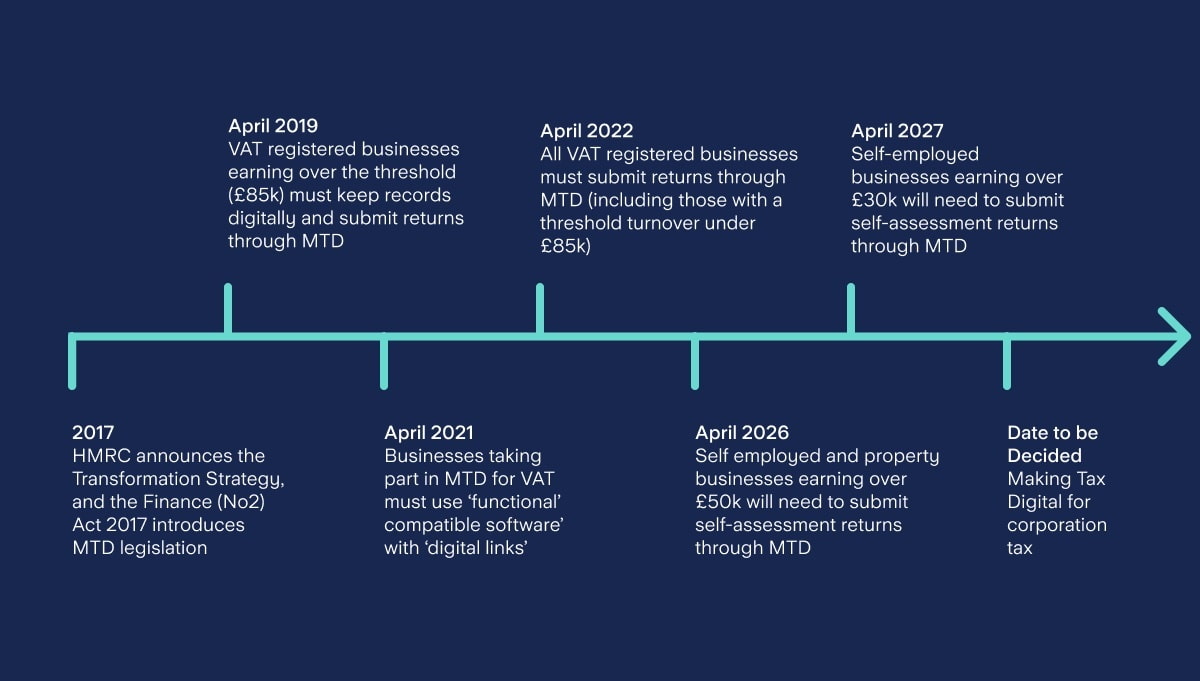
Tax
Making Tax Digital
Making Tax Digital (MTD) is an HMRC initiative to encourage businesses to keep their accounts up to date and in a digital format. MTD aims to help make tax admin more efficient.
Up to date accounts can help business owners keep better track of how their business is doing. It can also help in spotting any potential problems earlier on.
The MTD journey
Making Tax Digital covers VAT and, in the future, will extend to income tax self-assessment and corporation tax. Here’s a timeline of the government’s implementation plan:

MTD for VAT
MTD for VAT is the first phase of Making Tax Digital. From 1 April 2022 all businesses registered for VAT have been required to keep digital records, and to submit their VAT returns to HMRC using MTD compatible software – such as Toolkit.
On 1 November 2022, HMRC turned off the old VAT online account for all businesses, except for those that file VAT returns annually or have a digital exclusion exemption. The online VAT return will be closed for business filing returns annually on 15 May 2023.
Whilst MTD for VAT was being rolled out, VAT-registered businesses were required to separately register for MTD. From 1 November 2022, this was no longer the case as all remaining VAT registered businesses that had not yet registered for MTD were automatically enrolled by HMRC.
Any business newly-registered for VAT is also automatically enrolled for MTD. You don’t need to register for VAT unless your business’s annual turnover is above £85,000 per year, but you can voluntarily register if your turnover is under this threshold.
Read our guide to learn more on VAT and how to register.
MTD for Income Tax
Phase two will be MTD for Income Tax. This was expected to go live on 1 April 2024 but has now been delayed to 1 April 2026. The annual tax return will be replaced by four quarterly submissions plus a final adjustment submission.
If your accountant typically makes lots of adjustments at the year end it may be that some of these bigger tweaks need to be done in each quarterly return. For instance, if you’re recording your invoices mainly for VAT and credit control purposes, you may not usually adjust your stock or depreciation and capital allowance figures until the year end.
Digital Tax Accounts
HMRC have set up digital tax accounts for each individual and business. These allow the taxpayer to see, ‘in real time’, the updated records that HMRC holds for most taxes. Although this is referred to as real time, many records are only updated at certain times during the month or after a few days delay.
It’s also possible to make changes to some of those records online instead of having to write or hang on the telephone for an individual at HMRC to deal with the change.
Next steps
Find out more about phase 2 of MTD in our business guide Making Tax Digital: Extension to income tax self-assessment.
This article is intended as general information only and does not constitute advice in any way. For any specific questions, you may want to consult a qualified accountant.